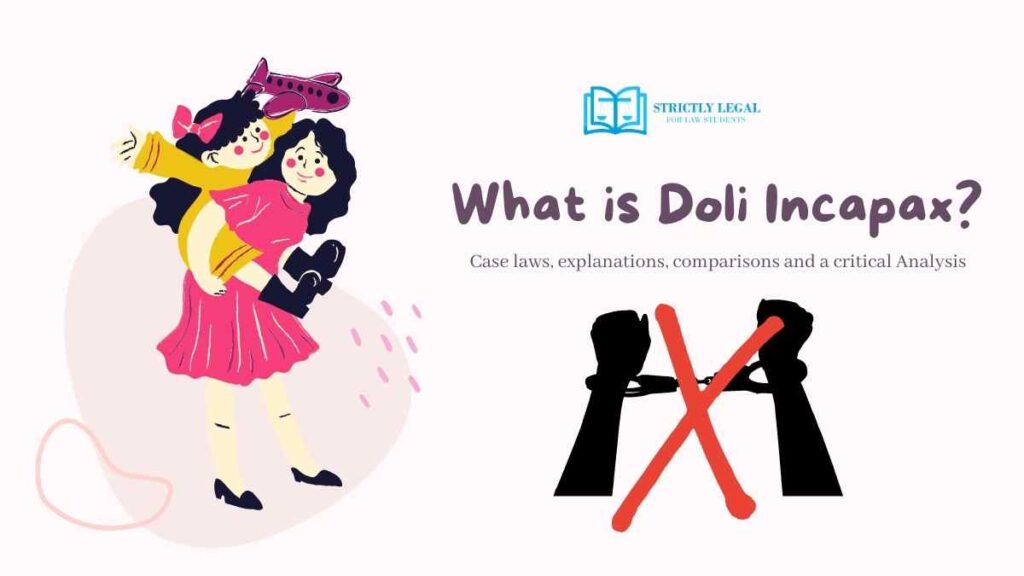‘Doli incapax‘ is a Latin legal maxim that infers the meaning ‘incapability of committing a crime’. This term has been used to describe an assumption of guiltlessness for children in criminal law in most countries. We find this term in the Indian Penal Code, 1860 in Section 82, and in the Juvenile Justice Act, 2015 in India.
In a Legal sense, both boys or girls under the age of 7 are held to be infants and cannot be charged for a crime as it is a defect of understanding in regard to what is a crime or what is not a crime. In other words, they are under a natural disability from distinguishing what is good and what is bad and are immune from punishment under English and Roman Law.
Table of Contents
What is section 82, Indian Penal Code, 1860?
(Also: what is doli incapax in IPC?)
An act of a child under seven years of age.—Nothing is an offense which is done by a child under seven years of age.
Section 82 of IPC:
Suppose a child who is below seven years of age, has a dangerous weapon in his hand, mistakenly triggers it and causes the death of any person on the opposite side. In such a case, that child will not be liable and will be protected by section 82 of IPC.
Illustration
‘A’ an adult in order to kill ‘B’, instigates a child ‘C’ of below 7 years to do an act which causes B’s death. Here, the child will not be liable for any crime as he is a “doli incapax”. However, A will be held liable for murder of B.
‘X’ an adult instigates a child ‘Y of 7 years to burn a dwelling house. Y without knowing the consequences of his actions burns the house. Here Y cannot be held liable under this section.
Illustrations
Therefore, It may be analyzed that a child below 7 years of age is absolutely immune to criminal liability and cannot be guilty of an offense under the Indian penal code.
Merely the evidence of that age would be a definite proof of the innocent child and would “ipso facto” (Latin phrase: “by the fact itself”) be an answer to any charge against that child.
While the Protection of Children from Sexual Offences Act 2012 (POCSO) does not include such a provision, the Indian Penal Code exemptions would apply to any POCSO offenses as well.
Relevant Case:
In Marsh v. Loader, the defendant caught a child stealing a piece of wood from his premises and was given in custody. Since he was below the age of 7 years, he was discharged.
Why does infancy act as a defence?
In these cases, the situation is based on the understanding that a child below the age of 7 years i.e. during infancy or in the state of babyhood, they do not have the mental ability to understand the nature and consequences of their actions and thus lacks the ability to form the requisite guilty mind or any intention.
It must be noted that such an age was not arrived at on the basis of any understanding of child psychology, but is “simply an expression of public policy”, “a practical working method ”, and not necessarily on “any observable fact.”
Since Doli incapex was already an established doctrine in English and Roman law, it can quite surely be inferred that the Indian Penal Code (IPC) has borrowed the concept from there, and hence no express reasoning for the ‘7 years’ age limit can be traced.
These children get defense as an “absolute immunity”. If a child crosses the age of 7 and commits the crime then the court will take necessary action such as mandatory therapy sessions based on that child’s maturity of understanding and capacity to commit a crime. It is also called a case of ‘qualified immunity’ and falls under section 83 of the Indian Penal Code.
Neuroscience suggests that the pre-frontal cortex (responsible for executive functions, such as problem-solving, planning, and decision making) is only fully developed after the age of 24. At 7 years old, our ability to fully comprehend the impact of our actions is simply not present. This could possibly give reason to the 7 years of age bar fixed.

What if the child is above 7 years but below twelve years of age?
(What is partially incapex?)
Act of a child above seven and under twelve of immature understanding.—Nothing is an offense which is done by a child above seven years of age and under twelve, who has not attained sufficient maturity of understanding to judge of the nature and consequences of his conduct on that occasion.
Section 83 of The Indian Penal Code
Ingredients:
- An Act is done by a child above 7 years but under 12 years of age.
- The Child should not have attained sufficient maturity of understanding to judge the nature and consequences of his conduct
- The incapacity must exist at the time of the commission of an act.
In other words, when a child is above the age of 7 but is still under the age of 12 he enjoys ‘qualified immunity‘. This means if his actions prove that had a sufficient understanding of the offence while he committed it, he can be prosecuted.
The test of sufficient knowledge depends on individual cases. For example, a child hiding murder weapons after murder would indicate that he had sufficient understanding of the fact that murder is an offence therefore, he shall be liable.
Can children never be charged with crimes?
In doli incapax under IPC, the presumption of section 83 is rebuttable, and the burden of rebutting lies upon the defendant. A child between 7 to 12 years of age has the defense of ‘doli incapax‘ if it is proved that the child didn’t have the maturity to understand the crime.
Basically, Between the age of 7 and 12, the CrPC provides for a presumption of innocence in favor of children, but if the prosecution can prove and provide evidence for the contrary then the child can be prosecuted.
But if the child is below 7 years then he or she enjoys absolute immunity and can in no circumstances be held liable.
Case laws for Section 83 or Partial Incapax
- In Krishna Bhagwan v. the State of Bihar, Patna High Court upheld that if a child who is accused of an offense during the trial, has attained the age of seven years or at the time of the decision the child has attained the age of seven years can be convicted if he has the understanding knowledge of the offense committed by him.
- In the case of Hiralal v. State of Bihar, an 11-year-old child quarreled with the deceased and threatened to cut the deceased into pieces. The child picked up the knife and actually stabbed the deceased to death.
The defense under Section 83 of the Indian Penal Code was pleaded. The trial court convicted the boy rejecting the defense because the child’s words, gesture, assault, keeping a knife and ultimately stabbing the deceased proved that the child had the knowledge and understanding of the consequences of his actions.
The Supreme Court upheld the decision of the High Court. - In Kakoo vs. The State Of Himachal Pradesh, Kakoo who was of thirteen years had committed rape on the child of 2 years and was sentenced to 4 years of rigorous imprisonment by the trial court, and the high court upheld the decision.
The defence counsel pleaded defence under section 82 and 83 of the Indian Penal Code.
This took place in 1976 when laws for juvenile and child delinquents were not fully developed, and Himachal Pradesh did not have any enactment in force at the time.
The court, however, stated, “taking into account all the circumstances of the case, we are of the opinion that the ends of justice will be served by reducing the sentence of the appellant to one year’s rigorous imprisonment and a fine of Rupees 2,000/-, and in default of payment of fine, to suffer six months’ further rigorous imprisonment. The appellant shall be detained separately from adult prisoners. He should preferably be detained in a Reformatory School, if any, for the said period. The fine, if realized, shall be paid as compensation to Shrimati Parmeshwari Devi, the mother of the victim baby.” - In the case of R v. LMW, a 10-year-old boy, LMW, was charged with the manslaughter of 6-year-old Corey Davis, who drowned on 2 March 1998. The defendant had dropped Corey into the Georges River, knowing that Corey was unable to swim.
The defendant was found not guilty of manslaughter, as the jury supported the defence case that the drowning of Corey had been ‘an act of bullying that went wrong’. This case raised the issue of Doli incapax, which presumes any child aged 7-12 is incapable of criminal intent unless proven otherwise. - In Krishna (1883) 6 Mad. 373, a 9 year child stole a necklace worth Rs. 280 and sold it to B, the accused for 5 annas. Evidence at the trial showed that the child had attained sufficient maturity of understanding the nature of act done and the consequences it would fetch. Therefore, the child notwithstanding doli incapax ipc section 83 was guilty of theft and B was charged under section 411 i.e guilty of recieveing stolen property.
Difference between Indian and England Law:
In India, a child below 7 years is considered to be absolutely immune from criminal liability whereas in England law the age is fixed at 10 years.
In 1998 the England Government abolished the principle of doli incapax. This was the presumption in law that children aged under 14 did not know the difference between right and wrong and were therefore not capable of committing an offense.
This presumption could be rebutted through the evidence for children between the ages of 10 and 14 if the prosecution could satisfy the court that the child knew that what the child was doing was seriously wrong, not “merely naughty or malicious”. In India, the child between the age of 7 to 12 enjoys a qualified immunity and is presumed to be in ‘doli incapax‘, therefore the burden to rebut the presumption lies upon him by proving that he was of that age group.
In England, a boy of 14 years of age cannot be convicted of rape or of any offense involving sexual intercourse. But in India there is no such immunity has been extended to boys which are the main criticism in this section of Indian Law.
Test of qualified immunity under section 83 IPC:

The test of qualified immunity is based on three factors :
- The nature of act done.
- Subsequent conduct of the offender,
- Demeanor and appearance of the offender in the court.
In Queen v. Lukhini Agradanini, a girl below 12 years of age was tried for a charge of arson. The Jury found the child was aware of the nature of her act, but she is not aware that she would be imprisoned in consequence.
Critiques on Indian Law:
It may be pointed out that Indian Law relating to infancy suffer from one lacuna, as section 82 deals with an act done by a child below 7 years and Section 83 deals with the child above 7 and below 12 years of age, both the sections make no provisions if that child is exact 7 years old.
It is submitted that such an infant should be dealt with under section 82 of the Indian Penal Code because penal statutes are interpreted strictly. And no judges are likely to hold a child of that age group criminally responsible without satisfying himself that the child has sufficient mental capability of understanding the nature and consequence of the Act.
This Principle is based on ‘quia malitia supplet actatem‘ which means ‘malice makes up for age’.
In Netherlands law it defines persons as – Child (<=12), Minor (>12 but <=16), Enhanced Minor (>16 but <=18) and Adult (>18). Dutch law also clearly exonerates any offense including murder committed by a Child.
According to Crime in India, 2015 data, 602 children below 12 years were seized in 2015 for offences. It is not clear how these children have been dealt with and what methods have been used by Juvenile Justice Boards to determine maturity.
Can the parents of the boy/girl be charged with a criminal offense for their children?
There is no such rule where the child’s parents would be held liable for their child’s offenses. However, in some cases, it requires very specific conditions to be met, such as instigating or abetting the child & an awareness of the child’s attempt to do (allegedly) something to the victim then only the parents may be liable.
Conclusion:
Justice Krishna Iyer’s poignant reflections on the law before the advent of standards on juvenile justice or developments in neuroscience are apt today:
“Adult intent, automatically attributed to infant men, is itself an adult error…. With all our boasts and all our hopes, our nation can never really be decriminalized until the crime of punishment of the young deviants is purged legislatively, administratively, and judicially.”
In Indian Law, it can be sufficiently proved that the accused child lacks the maturities capability to know or understand the nature of the consequence of their actions. The presumption of innocence is not in the favor of that accused child it has to be proved by the defendant that the accused child is in lack mentality in the intention of committing a crime i.e the ‘mens rea‘ without which a person shall not be prosecuted under criminal offense.
FAQ Answered
If the age of the child is below 7 years then he enjoys absolute immunity and cannot be held liable for a crime. But if the child is above 7 years but below 12 years of age then he enjoys qualified immunity where the prosecution must prove he had sufficient understanding of the act to make him liable.
Incapax in ‘doli incapax’ may refer to the inability to commit any crime because of the lack of understanding and nature of the act. This is a common law principle.
A document in furtherance of proof of birth should be enough evidence to convince the court that the child is doli incapax.
Section 84 lays down the McNaughton’s rule. The doctrine of Doli incapax is also known as McNaughton’s rule.
A person is said to be partially incapax if he is between the age of 7 to 12 and this is when he enjoys qualified immunity instead of absolute immunity.

Trying to learn the art of advocacy.
Practicing at the Calcutta High Court and in its vicinity.





